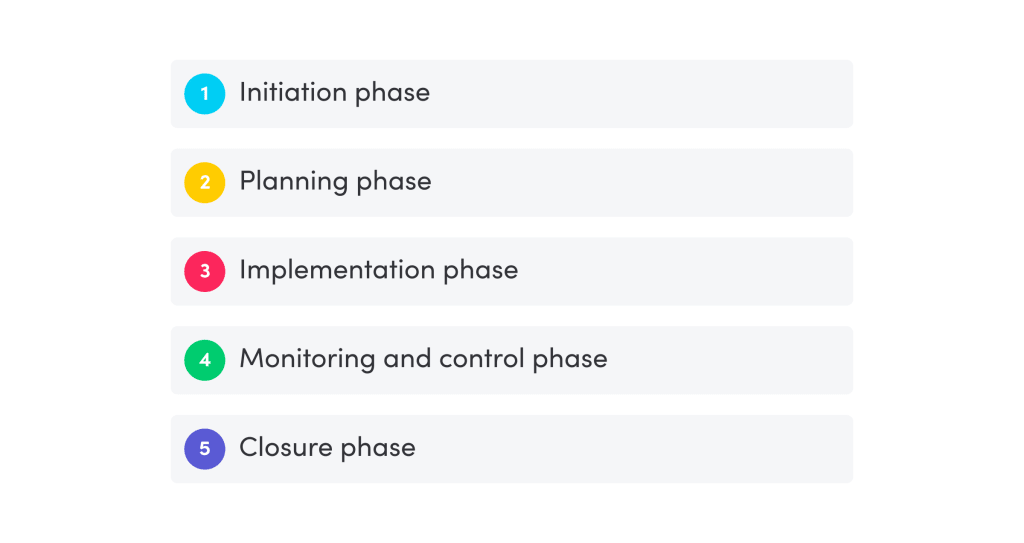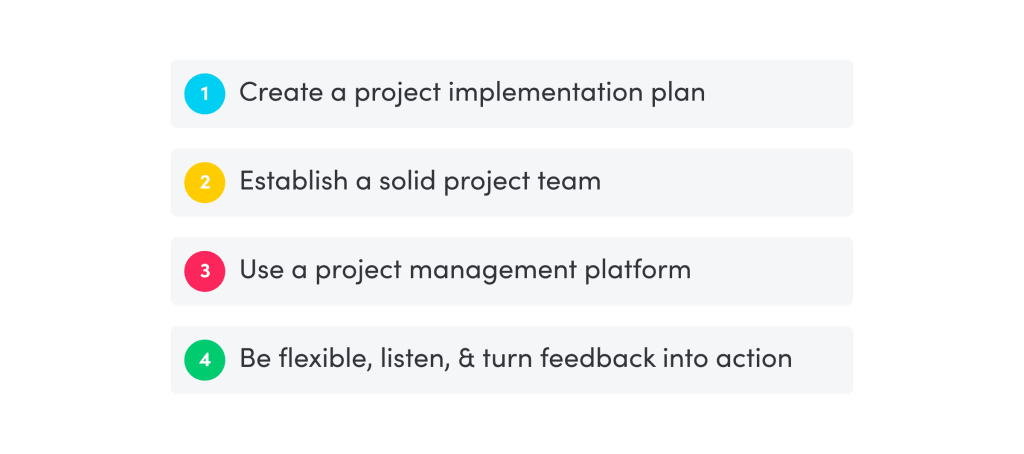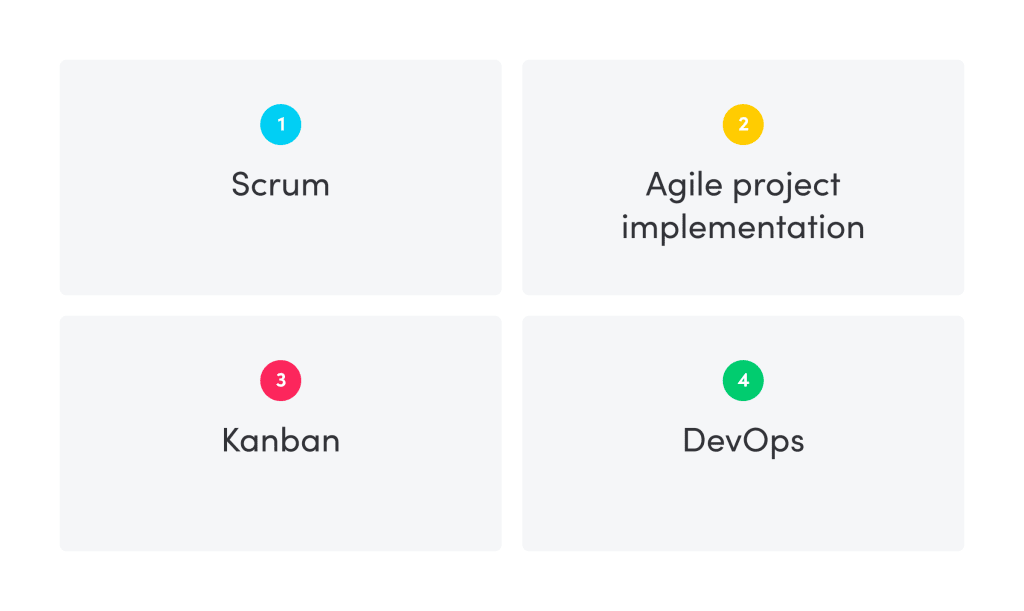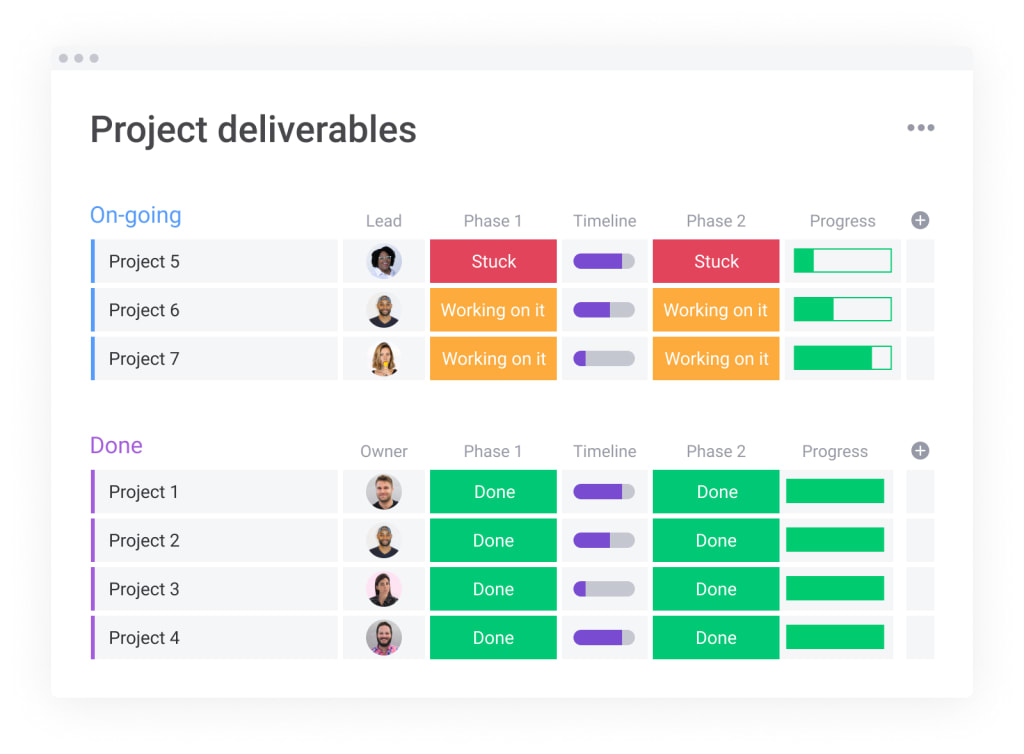Effective project management is like directing a play. There’s a lot of “behind-the-scenes” work leading up to the actual performance. Directors need to cast the right actors, run rehearsals, and work with designers and technicians.
But what happens if the play is a failure? Suddenly, all of the planning and rehearsing that came before no longer matters. Project managers face the same challenge.
PMs are master planners and communicators.
They’re skilled at coordinating tasks between teams, developing processes, and tracking progress. But if the project isn’t implemented properly, all of the hard work that led up to it loses its value.
Nailing the execution as planned is often more complicated than many realize.
Don’t let your hard work go to waste. We’ve compiled this official project implementation handbook to cover everything PMs need to know.
Are you ready to take your work – from planning to execution and beyond – to the next level?
Understanding implementation in project management
Leading successful project implementation requires understanding of all the project management phases.
Some project managers claim there are five distinct phases – while others say there are three. The number of phases depends on the type and complexity of the project.
For the purpose of explanation, we’ll cover five project phases. Each of these phases has a unique set of requirements that help drive the project through implementation.
- Initiation phase:
In the first phase, project sponsors and PMs launch, name, and define a project. In some cases, stakeholders perform feasibility studies and analyses to grasp the complexity of the project.
- Planning phase:
Project managers come up with the scope, cost, necessary resources, and potential risk for projects. PMs also define the milestones, timeline, deadlines and define how the team and stakeholders will touch base.
- Implementation phase:
The implementation consists of carrying out the project plan. By now, the deliverables get completed and the technical implementation is underway.
- Monitoring and control phase:
This phase runs at the same time as implementation. Here you assess how the final product fulfills the goals of the initial project plan. Use predefined metrics. You will also measure key performance indicators, such as progress, spending, and timeliness. If the outcomes of the project stray from the plan, use corrective measures to get the project back on track.
- Closure phase:
While some projects will continue as new processes, others will come to an end. Projects that end should have a formal closure. This is where you end external contractors and reward team members.
Without clear goals, a plan, resources, and communication, it’s unlikely implementation will work. To avoid failure, take the time to map out what gets done in each phase.
Two kinds of bottlenecks in project implementation
Bottlenecks are issues that arise during the course of the project. They delay the implementation – such as the introduction of new constraints or the loss of a needed resource. Project implementation bottlenecks are short-term or long-term.
- Short-term bottlenecks:
These could be a technical glitch, a supply chain mishap, short-staff or the absence of a key project stakeholder. Oftentimes, short-term bottlenecks are a surprise but get fixed as planning improves. Some quick ways to improve your processes are:
- Eliminating non-essential steps
- Using automation platforms to take over time-consuming manual work
- Establishing better communication to avoid misunderstandings and misalignment
- Long-term bottlenecks:
These pose a more severe threat because they are harder to resolve. Capacity is the most common long-term bottleneck. When employees working on projects have a lot of other tasks to manage, they have less time to focus on project-related tasks. How does this look like in real life? Companies that want to launch more features but don’t add programmers will face a bottleneck once employees meet capacity.
Unresolved bottlenecks have the potential to derail your entire project. The key to avoiding them is to expect them.
While you’re in the planning stage of your project, take some time to brainstorm potential short and long term bottlenecks. Think of what solutions will be necessary to prevent or stop them. You can get started on your project implementation journey on monday.com.
What is an implementation gap and how can I avoid it?
An implementation gap is a disconnect between what a project is supposed to achieve and its actual results. One common culprit is a lack of understanding between those who plan the project and those who carry it out. Poor alignment or consensus among leadership on the strategy itself is another.
Here are 3 tips to avoid an implementation gap in your initiatives:
- Ensure all the key stakeholders agree on the project’s strategy and main objectives during planning.
- Create an infrastructure and schedule to report on progress, use of budget, and milestones so there are no surprises at the end.
- Open direct feedback loops. This enables employees to ask questions, express concerns, and receive support to meet their duties.
Four tips for a successful implementation process
So, what can you do to ensure your project implementation will succeed? Consider these four tips.

1. Create a project implementation plan
Before diving into your initiative, it’s crucial to outline a clear, detailed project implementation plan. This plan should cover:
- The project’s objectives
- Key stakeholders and participants
- The timeline
- Budget
- Scope
- Any known obstacles or external constraints
Building your project implementation plan should help you achieve consensus and alignment between executives, department leaders and project managers. Establishing agreement on the points above is the best way to avoid an implementation gap.
2. Establish a solid project team
You can have a bullet-proof plan, but if you don’t have the right employees onboard, successful implementation will be difficult to achieve.
Who will be part of the project team depends on the type of project and its goals, but in any project, achieving a high level of buy-in is key. When each team member has a clear understanding of the project’s goals and believes in its necessity, it’s much easier to keep participants motivated and engaged.
3. Use a project management platform
When you’re leading a project’s implementation, you’re responsible for coordinating many moving parts. This could be managing the timeline, collecting status updates, and staying on top of your spend. Unless you use a formal system for monitoring progress and providing feedback, it’s difficult to track everything.
Project management platforms support teamwork and ease successful implementations. They make sharing information and resources easy and provide structure for reporting on progress and answering questions.
With the ability to manage all this information in one place, you can efficiently manage the course of your projects and end confusion. They also promote individual accountability and engagement to help each participant do their best work on time.
4. Be flexible, listen, & turn feedback into action
Although creating a detailed implementation plan is important, project managers should stay flexible.
You can’t control everything, and changes to the plan here and there are inevitable.
Routinely asking your team for their input on the project and its progress is a great way to stay informed about on-the-ground challenges and help address them. Listen often and take your team’s perspectives to heart. monday.com with project management is a great place to gather feedback and make improvements in your project implementation.
What is the role of a project manager in project implementation?
Project managers are responsible for guiding the development and execution of a project. They are the directors that turn a vision into reality.
A project manager is accountable for the scope of the project. It’s their job to outline the plan, put together the project team, and gather the necessary resources. They are also responsible for monitoring progress and the project’s success or failure.
Implementation as part of a team
While project managers take the lead role, project implementation is a team sport. Everyone on the project team gets selected to perform a specific, important function. Seamless collaboration, personal accountability, a strong sense of engagement, and communication by all team members is essential to success.
Four project implementation techniques to know
There are different project implementation methodologies that are used to guide successful execution. Here are a few:

- Scrum:
The scrum methodology focuses on producing project deliverables fast. In it, team members focus on high-value tasks on daily work “sprints” and relay their progress in daily check-ins.
- Agile project implementation:
With the agile technique, project leaders prepare their teams to adapt to project changes or developments. They don’t rely on rigid strategies and procedures. Instead, they pivot the plan as needed.
- Kanban:
The Kanban style of project management includes the use of a detailed visual that maps out the entire project and all of its stages. Like the agile method, teams that use Kanban are quick to adapt. With each change that arises, they re-map out the project until it is over.
- DevOps:
By now, DevOps has become the standard for software development teams. In this method, developers perform feedback, quality assurance, and security checks. They do this throughout the development process instead of at the end. This increases speed and lowers the number of time-consuming fixes that cause bottlenecks.
Successful project implementation at every stage
The pressure is high for project managers. Project managers have a range of responsibilities to manage and people to work with. To succeed, you need significant preparation to help turn your vision into reality.
We hope that this guide has given you valuable information! Make your next project implementation even easier with our project deliverables template below.


